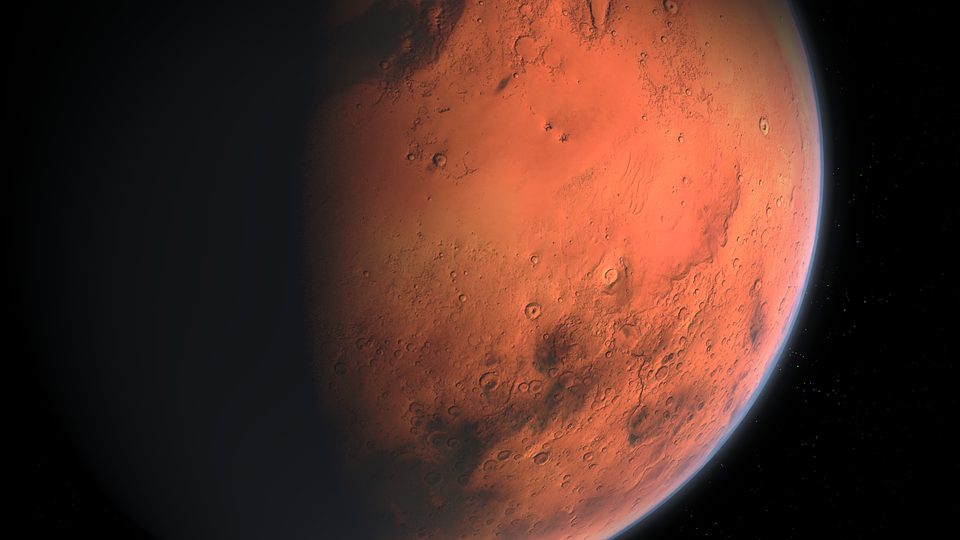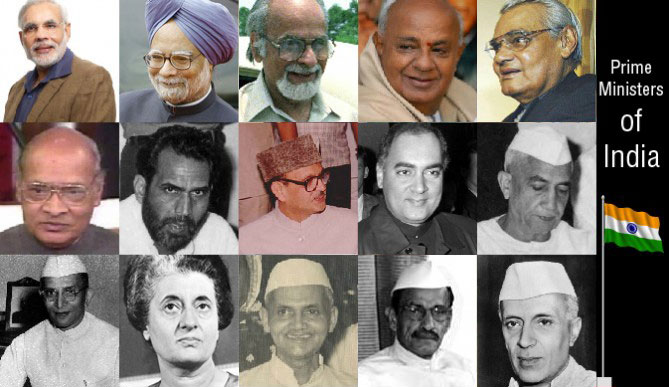The Mars Orbiter Mission (MOM), also called Mangalyaan, is India’s first foray into interplanetary travel. The unmanned MOM has been circling Mars since September 24, 2014, and will survey the surface of Mars and collect important information.
This article by Podium School answers any questions you may have about India’s mission to Mars.
- When did India launch Mangalyaan?
- What are the scientific objectives of the Mars Orbiter Mission?
- How much did the India’s mission to mars cost?
- Why was Mangalyaan launched on a PSLV rocket?
- What was the trajectory profile of the Mars Orbiter Mission?
- Is Mangalyaan still in commision today?
- What are some achievements of the Mars orbiter mission?
- Who were the scientists involved in India’s mission to mars?
- Is there a movie based on this mission?
When did India launch Mangalyaan?

The Indian Space Research Organization (ISRO) launched its first spacecraft to Mars on November 5, 2013. On September 23, 2014, the Mangalyaan spacecraft successfully reached Mars orbit, making ISRO the fourth space agency in the world to do so. The other agencies include NASA, the Soviet Union, and the European Space Agency (ESA).
What are the scientific objectives of the Mars Orbiter Mission?
Mangalyaan has two scientific objectives which are as follows:
- Its primary objective is to develop and test technology used in the design, planning, management, and operation of an interplanetary voyage.
- The second objective is to use indigenous scientific instruments to investigate Martian surface properties, morphology, minerals, and atmosphere.
How much did the India’s mission to mars cost?
Mangalyaan or MOM, ISRO’s most significant achievement, required an investment of only $74 million. This value is only 11 per cent of NASA’s MAVEN orbiter, which required an expenditure of more than $450 million to design and another $187 million to launch.
Why was Mangalyaan launched on a PSLV rocket?
ISRO originally planned to launch Mangalyaan on its Geosynchronous Satellite Launch Vehicle (GSLV) rocket rather than the less powerful Polar Satellite Launch Vehicle (PSLV). A GSLV rocket, like with most Mars missions, could have lifted Mangalyaan out of Earth’s orbit onto an interplanetary course to the Red Planet. However, the rocket had two failures in 2010. Repairing the flaws in the rocket’s architecture and prepping for another launch would’ve taken at least three years, putting it dangerously close to the satellite’s launch window in November 2013.
To avoid postponing the launch to 2016, ISRO opted to launch Mangalyaan on a PSLV rocket in 2013. However, the PSLV could only deploy Mangalyaan in the Earth’s elliptical orbit. Thus, it would be the spacecraft’s responsibility to fire its engines at exact moments in each orbit over a period of a few weeks in order to establish itself on a course to Mars. Although this trajectory design was out of the ordinary for a Mars trip, it worked wonderfully.
What was the trajectory profile of the Mars Orbiter Mission?
The profile of MOM had three phases, which are as follows:
The Geocentric Phase
During this phase, the launcher placed the spacecraft in an Elliptic Parking Orbit. Then, the spacecraft was progressively steered onto a departure hyperbolic trajectory with six main engine burns, allowing it to exit the Earth’s Sphere of Influence (SOI) at Earth’s orbital velocity. The Earth’s SOI terminates at 918347 km from the surface, after which the only perturbing force on the orbiter would have been from the Sun. ISRO employed a Hohmann Transfer Orbit, also known as a Minimum Energy Transfer Orbit, to transfer the spacecraft from Earth to Mars with the least amount of fuel possible.
The Heliocentric Phase
The spacecraft departed Earth in a path tangential to Earth’s orbit and collided with that of Mars’ in a direction tangential to it. The flight path was approximately one-half of an ellipse centred around the sun and would have eventually overlapped Mars’ orbit.
The Martian Phase
In a hyperbolic trajectory, the spacecraft arrived in the Mars Sphere of Influence, which is about 573473 km from Mars’ surface. When the spacecraft was close to Mars, it was caught into a predetermined orbit around the planet, which was known as the Mars Orbit Insertion (MOI) manoeuvre.
The diagram given below depicts the trajectory of MOM, which took 298 days to complete.
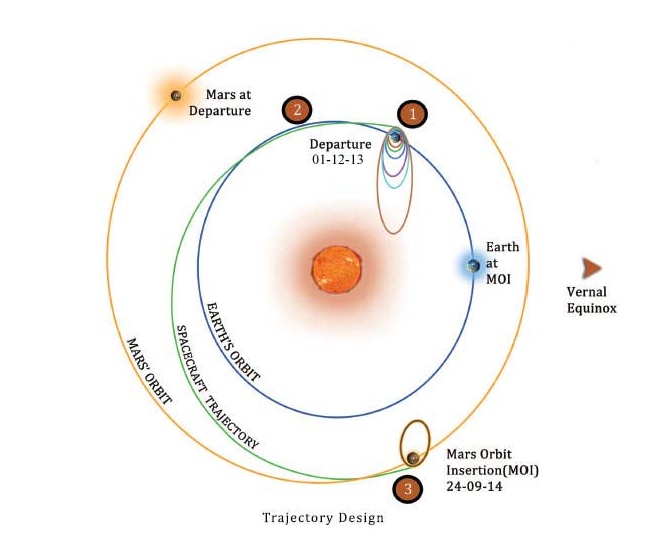
Is Mangalyaan still in commision today?
ISRO extended the mission’s lifespan from 6 months to 2-3 years in April 2015 because there was a sufficient amount of fuel remaining in the spacecraft. By then, the MOM had made nearly 8000 orbits of Mars. The spacecraft is still in orbit today, and in 2021, Mangalyaan completed seven Earth years in Mars’ orbit.
It was quite a marvel that a spacecraft designed to last only six months had actually orbited the red planet for seven years.
What are some achievements of the Mars orbiter mission?
The following are Mangalyaan’s significant achievements:
- The first Mars mission in history to achieve Mars Orbit Insertion on the first try.
- The first Indian spacecraft to successfully transit the Van Allen belt 39 times.
- It was the first Indian spacecraft to leave Earth’s sphere of influence and circle the Sun.
- The world’s most cost-effective interplanetary expedition, paving the door for other methods of cost-effective entry to deep space.
- Indian Space Research Organization’s (ISRO) Mars Orbiter Mission (MOM) crew received the National Space Society’s (NSS) “Space Pioneer Award” for research and engineering in 2015.
- ISRO received the Indira Gandhi Prize for Disarmament, Peace, and Development in appreciation of its ground-breaking achievements culminating in the Mars Orbiter Mission, as well as its contribution to the advancement of global cooperation in the peaceful use of deep space.
Who were the scientists involved in India’s mission to mars?
The following were the integral members of the Mangalyaan team:
- K Radhakrishnan led the team as the Chairman of ISRO.
- V Kesava Raju, the director of MOM
- V Koteswara Rao, the scientific secretary.
- B Jayakumar, responsible for testing the rocket systems, was an Associate Project Director at the PSLV programme.
- MS Pannirselvam, tasked to maintain launch schedules was the Chief General Manager at the Sriharikota Rocket port.
- Mylswamy Annadurai was the Programme Director. He was in charge of budget management, spacecraft configuration, scheduling and resource management.
- Chandradathan was the Liquid Propulsion System’s Director.
- The Director of the Satellite Application Centre was A. S. Kiran Kumar.
- SK Shivakumar, the Director of the ISRO Satellite Centre.
- S Ramakrishnan, the Director, helped develop the liquid propulsion system of the PSLV rocket.
- P. Kunhikrishnan, was the Project Director of the PSLV programme.
- Moumita Dutta, the Project manager of MOM.
- Nandini Harinath and Ritu Karidhal were the Deputy Operations Director of Navigation of the MOM.
- BS Kiran was the Flight Dynamics’ Associate Project Director.
- MYS Prasad, Satish Dhawan Space Centre’s Director.
- The Project Director of MOM, Subbiah Arunan.
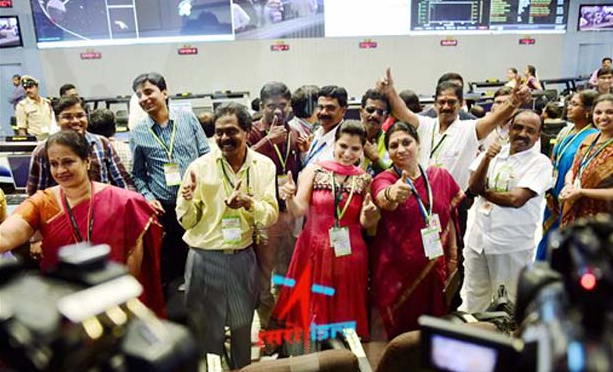
Is there a movie based on this mission?
“Mission Mangal”, a Hindi-language movie released in August 2019, portrays the true tale of the ladies behind India’s first Mars mission. Although the characters who make up the MOM team were modified in the film, the actors did an excellent job of depicting the commitment, effort, and scientific achievements of the women behind the Mars orbiter mission.
Mission Mangal also depicts what life is like at home for the MOM scientists, which, although not completely reflecting the mission’s real-life crew, gives dimension to the characters and demonstrates how living as an Indian lady may conflict with life as a scientist.
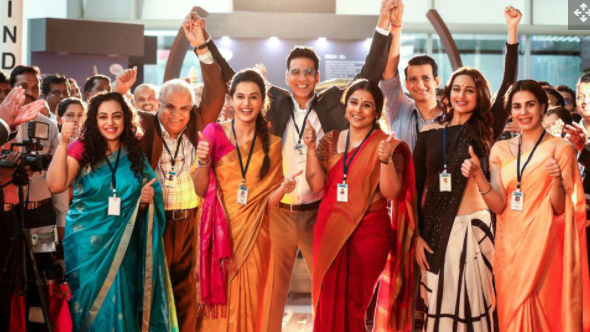
Share with your friends




